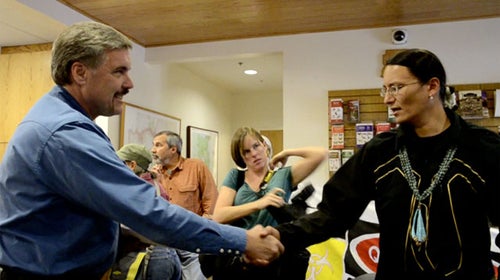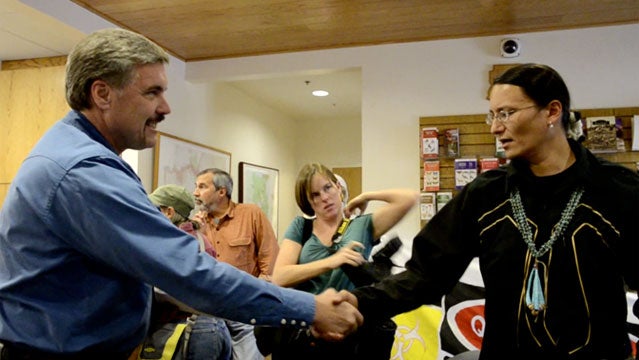For Navajo activist Klee Benally, the San Francisco Peaks mountain range in northern Arizona is where the world was created. The four tallest mountains there, like pillars, uphold his universe. Even people who don’t follow his religion, known as the Navajo Way, may be able to relate to the feeling that comes from being in a silent forest—what Emerson called, “a sanctity which shames our religions.”
Footage of the Protest
Benally and the other activists talk to Earl Stewart at the U.S. Forest Service office in Flagstaff.For Benally, the Peaks are nothing short of holy, and that is why, for 10 years, he’s fought Arizona Snowbowl’s upgrade plans that include clear-cutting 74 acres of forest and piping treated sewage effluent onto the mountain to make snow.
His most recent act of protest against Snowbowl has landed him with a complaint accusing him of violating federal law by disrupting work in a U.S. Forest Service office in Flagstaff, Arizona. He and three other protestors face fines of up to $5,000 and up to six months in jail each for the misdemeanor charges, according to a complaint filed in U.S. District Court.
The Forest Service owns the land where Arizona Snowbowl is located.
Wearing white suits and masks, the group displayed large banners, according to the complaint (PDF). Members of the public trying to buy permits and maps felt “intimidated” by the protestors and worried that they would not “be able to escape out of the building,” it contends.
The complaint, which was based on video surveillance that did not contain audio, goes on to say that the group began chanting loudly.
However, Benally said regional forester Earl Stewart received the group politely, shaking his hand several times, and that it was “a very cordial meeting.”
A video taken by a member of the protest group shows a couple conducting business at the front desk and protestors quietly standing around the perimeter of the room holding signs. Benally is so soft-spoken that his voice can scarcely be heard above the near-constant sound of a camera shutter as a photographer takes pictures of him.
The photographer, Laura Segall, was there to shoot a New York Times that ran just days after the protest and featured Benally.
Benally said he thinks the charges are trumped up and that the complaint, brought three months after the fact, is meant to “deter further protests” at Arizona Snowbowl as the resort gears up for its first ski season making the wastewater snow.
He also noted a bitter irony in the timing of the complaint, which was brought the same day that the Department of the Interior issued a . The Peaks are sacred to 13 Native American tribes, who view Snowbowl’s wastewater snow as a desecration.
The timing of the complaint “sends a message,” said Benally. “It shows the government’s lack of good faith.”
Benally and two of the other protesters turned themselves in to U.S. marshals Tuesday and were arraigned hours later. One of the conditions of their release, pending trial, is that they stay away from the National Forest offices and from Arizona Snowbowl. Benally, however, is allowed to visit the area so he can continue to practice his faith. Their next court appearances are scheduled for December 27.
is a freelance journalist who has written for the New York Times,��Associated Press, the Boston Globe, and others.


